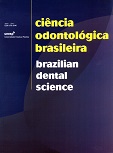Precisão de métodos radiográficos digitais para odontometria
DOI:
https://doi.org/10.14295/bds.2011.v14i1/2.653Keywords:
radiografia dentária digital, odontometria, endodontiaAbstract
O uso de radiografias digitais para a realização da odontometria tem ganhado espaço na endodontia, pois possui vantagens como menor tempo de exposição à radiação, manipulação e melhor visualização da imagem pelos softwares, armazenamento em computador, eliminação da película radiográfica e líquidos processadores. O objetivo deste estudo foi analisar a confiabilidade da odontometria realizada por diferentes métodos radiográficos digitais comparados à radiografia convencional. Para radiografia digital, foram comparados os aparelhos RVG Trophy 2000 (Trophy Radiologie, Vincennes - França) e DSX600 (OWANDY Dental Imaging Systems & Software), analisado pelo software Quickvision. Foram utilizados 50 dentes incisivos inferiores com abertura coronária, da disciplina de Endodontia da Faculdade de Odontologia de São José dos Campos, UNESP. O comprimento dos dentes foi aferido com um paquímetro eletrônico (CD-15CX, Mitutoyo - Japão) e o comprimento do canal radicular com limas endodônticas, medidas tidas como controle. O comprimento de trabalho foi estabelecido com a lima 2mm aquém do ápice radicular. Os dentes com as limas no comprimento de trabalho foram radiografados para posteriormente medir o comprimento do dente e comprimento de recuo. Através dos testes estatísticos ANOVA (5%) e Tukey, puderam-se verificar diferenças estatísticas somente nas medidas do recuo apical quando comparado o controle com o RVG. Pode-se concluir que os métodos radiográficos digitais utilizados apresentam apenas diferenças estatísticas, sendo insignificantes para a prática clínica, portanto considerados excelentes recursos de diagnósticos para a realização de odontometria.
Downloads
Downloads
Published
How to Cite
Issue
Section
License
Brazilian Dental Science uses the Creative Commons (CC-BY 4.0) license, thus preserving the integrity of articles in an open access environment. The journal allows the author to retain publishing rights without restrictions.
=================




























